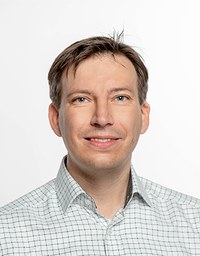Thin-skinned

In his works, Eric Beier often dispenses with an unambiguous human image; rather, he creates abstracted likenesses or materialized analogies in order to confront us with our own bodily condition.
This happens particularly impressively in his large-format picture object, which is presented classically like a painting on the wall, but whose spatial depth projects far into the viewer's space. The cross-genre work is reminiscent of the upholstery of a sofa set, which may have seen better days and shows signs of wear, even injuries, in various places. The disclosure of the deep green "upper skin" with its red lower frame gives us a deep look, the inner life flashes out in its soft golden materiality. The parallel between the cushion and the surface of the skin is obvious, the message unambiguous: thin-skinned is this object, vulnerable and above all no longer whole.
Another association tempts us to want to grasp this cushion haptically, to feel its tough and at the same time flexible surface, to accept the invitation of the soft bedding. It is not by chance that the idea of a "life raft" suggests itself next to the sofa cushion. Vulnerable but indestructible, it may carry you through all the ups and downs of life.
The second group of works by Eric Beier focuses on a novel imaging method for cancer surgery. Unlike the researchers, Beier does not work with short-wave infrared light, but with UV light. The diptych, two identically sized rectangles in white and orange with neon yellow belt structures, only reveals its "real" pictorial content under appropriate lighting: pictograms that make inclusion and participation visible in deconstructed ciphers. With this work, Eric Beier sensitizes us on the one hand to the often overlooked concerns of people with disabilities; on the other hand, the moment of "enlightenment" can also mean a light at the end of the tunnel.



Eric Beier (*1981 in Dresden, lives and works in Dresden)
The painter and installation artist is a master student of Prof. Christian Sery at the HfBK Dresden. After apprenticeship as an administrative assistant, he worked at the Max Planck Institute for Molecular Cell Biology and Genetics (MPI-CBG) in Dresden before studying painting and graphic arts. Beier was awarded the 2021 Saxon State Scholarship for Young Artists.
Project partners:


Prof. Oliver Bruns, Dr. Thomas Bischof – Innovative imaging for cancer surgery
Department of Functional Imaging in Surgical Oncology, NCT/UCC Dresden
Short-wave infrared light, newly developed fluorescent dyes and innovative camera systems are set to revolutionize imaging for cancer surgery in the future. The aim is to make cancer cells at tumor margins and in lymph nodes visible with high sensitivity during surgery. At the same time, structures such as nerves and blood vessels can be marked in different colors. The novel biomedical imaging method uses infrared light with wavelengths between 1,000 and 2,000 nanometers, which makes tissue appear transparent, and is expected to significantly increase precision and safety in tumor surgery.

Ulrike Knaebel, Maria Uhlig – Holistic care
Day clinic and outpatient clinic nursing, NCT/UCC Dresden
The nursing team at the NCT/UCC day clinic and outpatient clinic usually accompanies patients for many years during their tumor treatment. The staff give therapies, draw blood, and place accesses. They coordinate appointments for therapy and diagnostics and provide advice to those affected. They often share the ups and downs of treatment, laughing and crying with the patients. Unlike on the ward, the spectrum of different cancers in the outpatient clinic and day clinic is very wide, which makes the work particularly varied and challenging.


